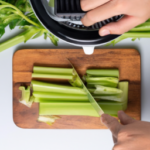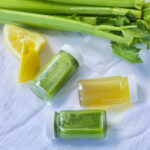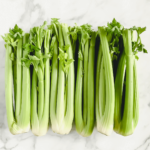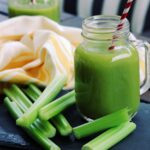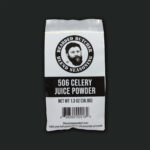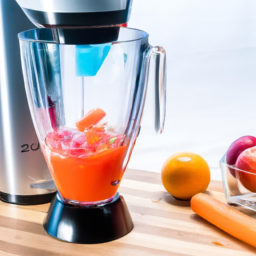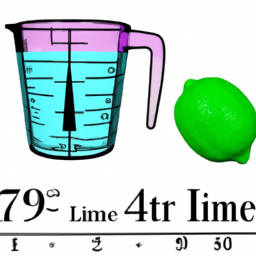Juicing celery has become a popular way to reap its numerous health benefits, such as reducing inflammation, improving digestive health, and enhancing skin condition. However, not everyone has a juicer on hand, whether due to limited access or unwillingness to invest. Thankfully, I am here to help you discover various methods to juice celery even without a juicer.
In this article, I’ll walk you through four different methods for juicing celery without a juicer, including using a blender, food processor, nut milk bag, or fine mesh strainer.
I’ll also provide tips for preparing celery before juicing, reusing the pulp, and storing and consuming the juice for maximum freshness and benefits. So, whether you’re a celery juice newbie or a seasoned pro, keep reading to learn how to make this healthy beverage without a juicer.
Key Takeaways
- There are multiple methods for juicing celery without a juicer, including using a blender, food processor, nut milk bag, or cheesecloth/fine mesh strainer.
- Proper preparation and storage of celery is important for juicing, including washing thoroughly, cutting off ends and brown spots, and storing in an airtight container in the refrigerator until ready to juice.
- Homemade juice is a cost-effective, customizable, and nutrient-dense alternative to store-bought juice, which may contain added sugars and preservatives and limited options for customization.
- Incorporating celery pulp into meals can reduce food waste and add nutrients and flavor to meals.
Benefits of Celery Juice
Here’s why you’ll want to add celery juice to your morning routine – it’s packed with nutritional properties, health benefits, and is a great way to start your day!
Celery juice is a nutrient-dense drink that can help you stay hydrated, reduce inflammation, and improve your gut health. It contains essential vitamins and minerals like vitamin K, vitamin C, potassium, and folate. Additionally, it’s packed with antioxidants that can help protect your body from harmful toxins, free radicals, and oxidative stress.
The health benefits of celery juice don’t stop there. Studies have shown that celery juice can help lower blood pressure, reduce the risk of heart disease, and even prevent certain types of cancer. It can also aid in weight loss and improve skin health.
So, if you’re looking to improve your overall health and wellness, adding celery juice to your daily routine is a great place to start.
Now, let’s talk about how to prepare your celery before juicing.
Preparation Before Juicing
Before juicing celery, it’s important to properly prepare it. First, I always wash the celery thoroughly to remove any dirt or debris. Then, I cut off the ends and any brown spots before chopping it into smaller pieces that will fit into my juicer.
Finally, I store the celery in an airtight container in the refrigerator until I’m ready to juice it. By taking these steps, I ensure that my celery juice is fresh, clean, and delicious.
Washing the Celery
To make sure your celery is clean and ready to juice, you’ll want to give it a good rinse under running water. Proper washing is crucial to remove any dirt or debris that may be on the celery. It’s also important to remove any pesticides or chemicals that may be present on the surface.
After washing the celery, it’s best to pat it dry with paper towels or a clean dish towel. This will remove any excess water and prevent diluting the juice. Proper storage techniques are also important to ensure the celery stays fresh for juicing. Keep it in the refrigerator in a plastic bag or container for up to a week.
Now that your celery is clean and prepped, it’s time to move on to cutting it for juicing.
Cutting the Celery
Get ready to slice up those crunchy stalks of celery! Before cutting into the celery, make sure to choose a sharp knife that’s comfortable to hold. A dull or poorly maintained knife can make the task more difficult and potentially dangerous.
Hold the celery stalk firmly on a cutting board and use a slicing motion to cut it into pieces. You can cut it into small pieces for easier blending or leave them longer for a more rustic texture.
When using a knife, it’s important to prioritize safety. Always keep your fingers away from the blade and be mindful of where it is at all times. If you’re not confident in your cutting technique, consider investing in a pair of cut-resistant gloves.
Once you’ve finished cutting the celery, move on to the next step of storing it properly.
Storing the Celery
Now that you’ve sliced up your celery, it’s time to store it properly so it stays fresh and crisp for longer. Proper storage is key in maintaining the quality of your celery.
To start, remove any leaves from the stalks and place them in a plastic bag or container. Keep them in the crisper drawer of your refrigerator, which is designed to maintain a consistent temperature and humidity level. Celery can last up to two weeks when stored properly.
It’s important to note that the shelf life of celery depends on how fresh it was when you purchased it. Always check for any signs of wilting or discoloration before buying. Additionally, avoid storing your celery near fruits like apples or bananas, as the ethylene gas they produce can cause it to spoil faster.
Now that your celery is properly stored, it’s time to move on to the next step in the process of juicing celery without a juicer – the blender method.
Blender Method
Using a blender to juice celery may seem unconventional, but it’s actually a simple and effective method. When I don’t have access to my juicer or want a quick alternative, I turn to my blender for celery juice. Here’s how:
-
Chop celery into small pieces: Before adding the celery to the blender, chop it into small pieces. This will help the blender break down the celery more easily.
-
Add water: To help the blender blend the celery, add a small amount of water to the blender. The amount of water needed will depend on the amount of celery being juiced.
-
Blend: Blend the celery and water until it becomes a smooth consistency.
-
Strain: Pour the blended celery through a fine-mesh strainer to separate the juice from the pulp. Use the back of a spoon to press the pulp against the strainer to extract as much juice as possible.
Although the hand juicing technique can be a workout, it’s another blender alternative to consider. Simply chop the celery into small pieces and add to a large bowl. Use a potato masher or a pestle to mash the celery until the juice is extracted. Strain the juice through a fine-mesh strainer and enjoy.
Now, let’s move on to the next method: the food processor.
Food Processor Method
If you’re looking for a method that requires minimal effort and still yields a smooth consistency, the food processor technique might be just what you need. This method involves chopping the celery into small pieces and adding them to the food processor with a small amount of water.
Once the celery is blended, you can strain it through a fine mesh strainer to remove any pulp. This method is great for those who don’t have a juicer, as it allows you to extract the juice from the celery with minimal equipment.
Not only is the food processor method easy, but it also preserves the majority of celery juice nutrition. Celery juice is known for its high levels of antioxidants and anti-inflammatory properties. It’s also a great source of vitamins and minerals such as vitamin K, vitamin C, potassium, and folate.
By using the food processor technique, you can make sure that you’re getting all of these health benefits in your celery juice. If you’re not satisfied with the consistency of your celery juice after using the food processor method, don’t worry. There’s another technique that you can try: the nut milk bag method.
Nut Milk Bag Method
I prefer using the nut milk bag method when juicing celery without a juicer.
To prepare the nut milk bag, I rinse it with water and wring out any excess water. Then, I place it over a large bowl or pitcher.
To strain the juice, I simply pour the blended celery into the nut milk bag and gently squeeze the bag to extract the juice.
How to Prepare the Nut Milk Bag
First, grab your nut milk bag and give it a quick rinse with cool water. It’s important to properly clean the nut milk bag before every use to prevent any contaminants from getting into your juice. Here are some tips for maximizing the juice yield from the nut milk bag:
- Squeeze out any excess water from the bag before using it.
- Cut the celery into smaller pieces to make it easier to juice.
- Place the celery pieces into the nut milk bag and twist the top of the bag to close it.
- Squeeze the bag tightly to extract as much juice as possible.
By following these tips, you can ensure that you get the most juice out of your celery using the nut milk bag method.
Now that you have prepared the nut milk bag, it’s time to strain the juice!
How to Strain the Juice
To strain the juice using your nut milk bag, all you need to do is pour the blended mixture into the bag and gently squeeze it to extract the delicious, nutrient-rich liquid. It’s that simple! The nut milk bag is a fantastic tool for juicing celery without a juicer since it effectively separates the fiber from the juice, resulting in a smooth and refreshing beverage.
However, if you don’t have a nut milk bag on hand, don’t worry! There are other straining alternatives you can use. For example, you can use a fine-mesh strainer or a cheesecloth. Just be aware that these methods may not be as effective as using a nut milk bag and may require more effort to get all the juice out. With these straining tips in mind, let’s move on to the next section about the cheesecloth method.
Cheesecloth Method
I’ve found that using a cheesecloth to juice celery is another great method that doesn’t require a juicer.
To get started, you’ll need to cut a piece of cheesecloth that’s large enough to hold your celery stalks. Then, fold the cheesecloth in half so that you have two layers to strain the juice through.
When it’s time to strain the juice, simply pour the blended celery into the cheesecloth and use your hands to squeeze out all the liquid.
How to Prepare the Cheesecloth
Now, you may be wondering how to prepare your cheesecloth to get started on juicing celery without a juicer. To start, it’s important to choose the right cheesecloth material. Look for a cheesecloth with a fine mesh that will effectively strain the celery pulp from the juice. Cotton or muslin cheesecloth is a good option and can be found at most kitchen supply stores or online.
Once you have your cheesecloth, cut it into small squares and dampen them with water before use. This will help the cheesecloth cling to the celery pulp and prevent it from slipping through the mesh. Simply wring out the excess water before placing the dampened cheesecloth over a container to catch the juice.
With the cheesecloth prepared, it’s time to move on to how to strain the juice without a juicer.
(Note: Avoid using cheesecloth that’s been bleached or has any added chemicals, as these can affect the taste and quality of the juice.)
How to Strain the Juice
Get ready to experience the satisfaction of extracting every last drop of nutrient-rich goodness from your celery, all thanks to this simple straining technique.
To strain the celery juice, you’ll need a few pieces of equipment. First, you’ll need a large bowl to catch the juice. Then, you’ll need a cheesecloth that’s been prepared by folding it into four layers. Finally, you’ll need a pair of tongs to hold the cheesecloth in place while you pour the juice.
To start, take the prepared cheesecloth and place it over the large bowl. Make sure it’s secure and won’t fall into the bowl while you pour the juice.
Then, pour the celery juice into the cheesecloth. The cheesecloth will catch any pulp or fibers, leaving you with smooth, pure celery juice.
Once you’ve poured all the juice, use the tongs to gently squeeze the cheesecloth to extract every last drop of juice. And with that, you’ve successfully strained your celery juice!
Now, let’s move on to the next method, the fine mesh strainer technique.
Fine Mesh Strainer Method
I prefer using a fine mesh strainer to extract juice from celery when I don’t have access to a juicer. The process is simple and can be done in just a few steps.
First, chop the celery into small pieces and blend them with some water in a blender. Then, pour the mixture through the fine mesh strainer, using a spoon to press the celery pulp against the strainer and extract as much juice as possible.
How to Use a Fine Mesh Strainer
First, you’ll need to chop the celery into small pieces before placing them in a blender along with a small amount of water. This will help break down the fibers and make it easier to extract the juice.
Once blended, pour the mixture through a fine mesh strainer over a bowl. Using a spatula or spoon, press the pulp against the strainer to extract as much juice as possible.
Using a fine mesh strainer is a great alternative method to juicing celery without a juicer. However, it may take some time and effort to extract the juice. But the end result’s worth it – a refreshing and nutritious drink that can provide numerous health benefits.
How to Strain the Juice
Now that we know how to use a fine mesh strainer to extract juice from celery without a juicer, the next step is to strain the juice. Straining is an important part of the process as it removes any remaining pulp and fiber from the juice. To strain the juice, you will need a few additional materials such as a clean bowl or pitcher, a spoon or spatula, and a cheesecloth or nut milk bag.
There are several straining alternatives to choose from, including using a cheesecloth or nut milk bag, a coffee filter or paper towel, or even a fine mesh sieve. Whichever method you choose, it is important to take your time and be patient as straining can be a slow and tedious process. If you encounter any issues, such as clogging or slow draining, refer to our troubleshooting tips in the table below to help make the process smoother. Once you have strained the juice, you can move on to the next step of reusing the pulp.
| Straining Alternative | Pros | Cons |
|---|---|---|
| Cheesecloth or Nut Milk Bag | Reusable, easy to use | Can be messy, may take longer to strain |
| Coffee Filter or Paper Towel | Readily available, inexpensive | May tear or break, can be wasteful |
| Fine Mesh Sieve | Quick and efficient | May not remove all pulp, may require multiple straining |
As you can see, there are a variety of methods to choose from when it comes to straining your celery juice. With a little patience and practice, you can find the perfect method that works for you. Now that we have successfully strained our juice, let’s move on to the next step of reusing the pulp.
Reusing Pulp
To make the most of your celery pulp, try using it in soups or as a base for vegetable broth. Here are some creative recipes for celery pulp that you can try:
-
Celery Pulp Soup: This soup is easy to make and is a great way to use up leftover celery pulp. Simply sauté onions and garlic in a pot, add the celery pulp, some vegetable broth, and let it simmer for 20-30 minutes. Blend the mixture until smooth and add salt and pepper to taste.
-
Celery Pulp Juice: You can also reuse your celery pulp to make a nutritious juice. Mix the pulp with some water and blend it until smooth. Strain the mixture through a fine mesh sieve or cheesecloth and add some lemon juice and honey for a delicious drink.
-
Celery Pulp Crackers: Mix the celery pulp with some almond flour and spices to create a dough. Roll the dough out thinly and cut into crackers. Bake in the oven until crispy and enjoy as a healthy snack.
-
Celery Pulp Dip: Mix the celery pulp with some Greek yogurt, garlic, and herbs for a tasty dip. Serve with vegetables or crackers for a healthy snack or appetizer.
Using celery pulp in these creative ways not only reduces food waste but also provides additional nutrients and flavor to your meals. Now that you know how to reuse your celery pulp, let’s move on to the next step: storage and consumption.
Storage and Consumption
When storing your leftover celery pulp, proper storage is crucial to ensure its freshness and optimal consumption. I recommend sealing it tightly in a container and storing it in the refrigerator. This keeps the pulp moist and fresh, making it easier to use later on.
When you’re ready to use the leftover pulp, there are a variety of ways to incorporate it into your meals. You can add it to soups, stews, or smoothies for an extra boost of nutrients. You can also mix it with breadcrumbs to use as a filler in meatballs or burgers. The possibilities are endless!
With proper storage and optimal consumption, you can make the most out of your celery pulp and reduce food waste. There are many ways to reuse celery pulp without a juicer. From reusing the pulp to proper storage and optimal consumption, you can turn your celery scraps into something delicious and nutritious.
With a little creativity and some experimentation, you can make the most out of your leftover celery. Happy juicing!
Final Thoughts and Tips
I want to wrap up this guide with some final thoughts and tips on juicing celery at home.
First of all, there are numerous benefits to juicing at home rather than buying pre-made juices from the store. You have more control over the ingredients and can ensure that your juice is fresh and free from additives.
Secondly, when juicing celery specifically, it’s important to use a high-quality juicer or follow one of the methods we discussed earlier to extract the juice properly.
Finally, I recommend experimenting with different ingredients and ratios to find the perfect juice for your taste preferences and health goals.
Benefits of Juicing at Home
You can easily reap the benefits of juicing at home by using fresh produce and a blender or food processor. Not only is it a cost-effective option, but it also allows you to customize your juice to your liking and ensure that it is free from any preservatives or added sugars that may be found in store-bought juices. When it comes to juicing equipment, a blender or food processor can be a great alternative to a juicer. While a juicer may extract more juice from the produce, a blender or food processor can still produce a nutrient-dense juice that is packed with vitamins and minerals.
To help you understand the benefits of juicing at home, here is a table comparing store-bought and homemade juice:
| Store-Bought Juice | Homemade Juice | |
|---|---|---|
| Nutrient Content | May have added sugars and preservatives | No added sugars or preservatives |
| Cost | Expensive | Cost-effective |
| Customization | Limited options | Can customize to personal preferences |
| Freshness | May not be as fresh | Uses fresh produce |
By juicing at home, you can ensure that you are getting a fresh and nutrient-dense juice that is tailored to your preferences. Plus, it can save you money in the long run. With these benefits in mind, let’s move on to some tips for juicing celery at home.
Tips for Juicing Celery at Home
After learning about the numerous benefits of juicing at home, I’m excited to share some tips for juicing celery at home. Celery juice has become increasingly popular in recent years due to its potential health benefits, including reducing inflammation, improving digestion, and boosting energy levels.
However, not everyone has a juicer at home, which is why I’m going to share some alternative methods and equipment-free options for juicing celery.
One of the easiest ways to juice celery without a juicer is to use a blender. Simply chop the celery into small pieces and add them to the blender with a small amount of water. Blend on high until the celery is pureed, then strain the mixture through a fine mesh strainer or cheesecloth to remove any pulp.
Another option is to use a food processor to puree the celery, then strain it through a nut milk bag or cheesecloth. Both of these methods may require a bit more effort than using a juicer, but they’re still effective ways to extract the juice from celery without any fancy equipment.
Frequently Asked Questions
Is it safe to consume celery juice every day?
Drinking celery juice every day has numerous benefits, such as improved digestion and immune function. However, precautions should be taken for those with kidney problems. As always, consult with a healthcare professional before making any drastic changes to your diet.
Can I freeze celery juice for later consumption?
Yes, celery juice can be frozen for later consumption. The best storage method is to transfer the juice into an airtight container and freeze it immediately. Incorporate celery juice into meal prep by adding it to smoothies or using it as a base for soups and sauces.
Can I add other fruits or vegetables to my celery juice?
Oh yeah, because celery juice isn’t trendy enough on its own. But seriously, adding other fruits and veggies to your juicing combinations can enhance the nutritional benefits. Think spinach, cucumber, and green apple for a tasty boost.
How long does it take to clean up after juicing celery?
Cleaning up after juicing celery can take anywhere from 5-15 minutes depending on the method used. Time-saving methods include lining the juicer pulp bin with a plastic bag or using a strainer to catch pulp. Cleaning tips include rinsing parts immediately and using a brush to remove stubborn pulp.
Are there any potential side effects of consuming celery juice?
Possible answer:
I’ve researched the potential side effects of consuming celery juice and found no evidence of harm. In fact, celery is a nutrient-rich food that may support a juice cleanse and provide various health benefits.
Conclusion
In conclusion, juicing celery is a fantastic way to reap its many benefits. It can reduce inflammation, improve gut health, boost energy, and aid in weight loss. Juicing can seem intimidating, but there are several methods that don’t require a juicer. You can use a blender, food processor, nut milk bag, or fine mesh strainer to make a refreshing and nutritious drink.
As you embark on your celery juicing journey, remember to always prepare before juicing, reuse pulp in recipes, and properly store and consume your juice. Don’t forget to have fun with it! Experiment with different combinations of fruits and vegetables to create your own unique juice blends.
With a little bit of effort and creativity, you can easily incorporate celery juice into your daily routine and reap the many benefits it has to offer. So go ahead, give it a try and see how it transforms your health and wellbeing.
Ilana has been a vegan for over 10 years. She originally made the switch for health reasons, but soon found herself becoming more and more passionate about the ethical and environmental implications of a vegan lifestyle. Ilana is the author of The Graceful Kitchen, a blog all about veganism. She loves to cook up delicious and nutritious vegan meals, and share her recipes with others who are interested in leading a cruelty-free life. Ilana is also a strong advocate for using whole foods as the foundation of a healthy diet, and believes that going vegan is one of the best ways to achieve this.



